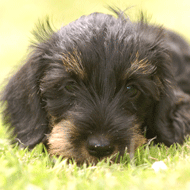Latest test results for lafora in dachshunds

Latest tests show 8 per cent of dachshunds were affected.
Recent screenings for lafora's disease in miniature wire-haired dachshunds has revealed that 42 per cent of those tested are carriers of the disease.
The Dachshund Breed Council has reported the findings, which are in line with earlier results. Screenings from last November show 8 per cent of participating dogs were affected with lafora, while 50 per cent were clear.
Lafora's disease is a late-onset form of epilepsy affecting miniature wire-haired dachshunds, as well as beagles and basset hounds. Symptoms include the development of head and neck jerking when the dog is stimulated. Over time, it can lead to blindness and dementia.
The test is offered by Dr Berge Minassian from the Hospital for Sick Children in Canada, and was developed in conjunction with the Wire-Haired Dachshund club.
More than 400 dogs have now been tested and received their results. Of these, 250 were tested with the full DNA affected/carrier/clear test.
The breed council has urged breeders and stud dog owners to offer their support to the testing programme, by only breeding dogs that have received a negative test result for lafora.
Owners of the 8 per cent of dogs found to be affected with lafora have been encouraged to join the active Lafora Support Group and participate in the lafora progression research project, which aims to improve understanding of the management of the disease.
Speaking at the breed council's recent Neurology seminar in Surrey, neurology expert Dr Clare Rusbridge, said 45 per cent of an affected dog's life could be spent suffering debilitating jerking, seizures, confusion, anxiety, possible hallucination, difficulty walking and blindness.
Test results have been supplied to the Kennel Club and a new DNA testing scheme for the disease has been approved.



 The RCVS has announced a new version of its 1CPD mobile app, with enhanced features for veterinary surgeons and veterinary nurses to record their continuing professional development.
The RCVS has announced a new version of its 1CPD mobile app, with enhanced features for veterinary surgeons and veterinary nurses to record their continuing professional development.